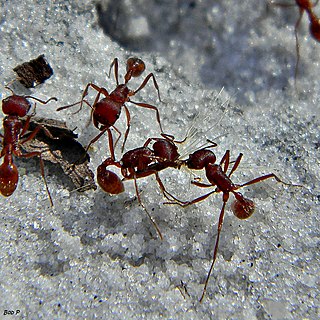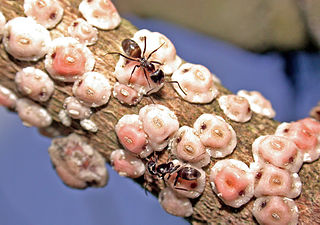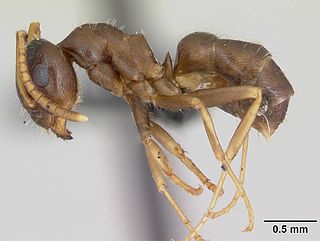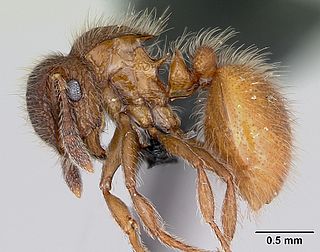
Tetramorium atratulum is a rare workerless socially parasitic ant from the Palaearctic region, which has even been introduced together with its host in North America. This extreme inquiline is represented only by female and pupoid type male individuals, whose morphology and anatomy indicate a highly specialized level of parasitism. The body of males is depigmentated, the cuticle is thin, the petiole and postpetiole are widely connected, and degenerate mandibles, palps, and antennae are observed. Female wing venation is reduced and the occipital region is narrowed. Mature females are typically physogastric and found in queenless host nests.

Harvester ant, also known as harvesting ant, is a common name for any of the species or genera of ants that collect seeds, or mushrooms as in the case of Euprenolepis procera, which are stored in the nest in communal chambers called granaries. They are also referred to as Agricultural ants. Seed harvesting by some desert ants is an adaptation to the lack of typical ant resources such as prey or honeydew from hemipterans. Harvester ants increase seed dispersal and protection, and provide nutrients that increase seedling survival of the desert plants. In addition, ants provide soil aeration through the creation of galleries and chambers, mix deep and upper layers of soil, and incorporate organic refuse into the soil.

Dorymyrmex is a genus of ants in the subfamily Dolichoderinae.

Megalomyrmex is a genus of ant in the subfamily Myrmicinae. The genus is known only from the Neotropics, where some of the species are specialized parasites or predators of Attini.

Lasius neglectus is a polygynous, sometimes invasive, ant of the genus Lasius. The ant was identified in 1990 after establishing a colony in Budapest, Hungary. Superficially, they are similar in appearance to the common black garden ant, Lasius niger, but have significantly different behavioural patterns, particularly in the social structure within colonies.

Aulacopone is a genus of ant in the subfamily Heteroponerinae containing the single species Aulacopone relicta. The genus was described by Arnoldi (1930) from a unique dealate female collected at Ələzəpin (Alazapin), near Lankaran, in Azerbaijan S.S.R., Soviet Union, near its border with Iran. The specimen was taken in galleries of the formicine ant Lasius emarginatus, under the bark of an oak stump, in mid-montane forest.

Vicinopone is a monotypic Afrotropical genus of arboreal ants in the subfamily Dorylinae. Vicinopone conciliatrix, the only species in the genus, was first described as Simopone conciliatrix by Brown in 1975 and was transferred to its own genus by Bolton & Fisher in 2012. V. conciliatrix appears to be quite widely distributed but rare. Its rarity is more likely apparent than real because it nests and forages in trees, rarely if ever coming down to the ground.
Megalomyrmex mondabora is a Neotropical species of ants in the subfamily Myrmicinae. Known from Costa Rica. In Costa Rica this species occurs in wet forest habitats, typically in mature rainforest. Collections are from sea level to 800 m elevation on the Atlantic slope of the Cordillera Volcanica Central, Cordillera de Talamanca, and Cordillera de Guanacaste. It is a specialized nest parasite of attines and is found most often in nests of Cyphomyrmex cornutus. It cohabits with C. cornutus in their nests, feeding on both host brood and the host's fungal symbiont.

Dinoponera quadriceps is a queenless species of ants in the subfamily Ponerinae. The species, known from Brazil, is similar to Dinoponera mutica and uses venom for subduing large live prey and defense. Its venom could be of use to the pharmaceutical industry.
Megalomyrmex wallacei is a Neotropical species of ants in the subfamily Myrmicinae. Megalomyrmex wallacei can be found in Brazil, Guyana, Colombia, Costa Rica. This species occurs in mature wet forest, usually low-elevation rainforest. Brandão (2003) reports the species nesting under leaves on the forest floor, in colonies of up to 300 workers.
Megalomyrmex modestus is a Neotropical species of ants in the subfamily Myrmicinae. Known from Costa Rica, Panama, Colombia, Venezuela.
Megalomyrmex adamsae is a Neotropical species of ants in the subfamily Myrmicinae. Megalomyrmex adamsae, known from Panama, is very similar to M. symmetochus, known from Costa Rica to Panama.
Megalomyrmex wettereri is a Neotropical species of ants in the subfamily Myrmicinae. Megalomyrmex wettereri is known from two lowland rainforest sites: Barro Colorado Island in Panama and La Selva Biological Station in Costa Rica.

Megalomyrmex silvestrii is a Neotropical species of ants in the subfamily Myrmicinae. Megalomyrmex silvestrii is widespread in the mainland Neotropics from Mexico to northern Argentina. This species occurs in moist to wet forest habitats, from sea level to 1100 m elevation. It nests in small chambers in rotten wood or opportunistically in other small cavities in the soil. Colonies have been found in small attine nests and alone, suggesting it is a facultative predator of small Attini.
Sphinctomyrmex marcoyi is a Neotropical species of ants in the subfamily Dorylinae. It is the only Sphinctomyrmex species recorded in the Amazon Forest. Gynes and males are unknown.
Stenamma andersoni is a Neotropical species of ant in the subfamily Myrmicinae.
Dorymyrmex amazonicus is a Neotropical species of ant in the subfamily Dolichoderinae.

Phrynoponera gabonensis is an Afrotropical species of ant in the subfamily Ponerinae. P. gabonensis is the most common, widely distributed and frequently encountered member of the genus Phrynoponera. Specimens are usually retrieved from leaf litter samples but also occur in pitfall traps. The species is known to nest in and under rotten wood, in compacted soil and in termitaries.

Slave-making ants are brood parasites that capture broods of other ant species to increase the worker force of their colony. After emerging in the slave-maker nest, slave workers work as if they were in their own colony, while parasite workers only concentrate on replenishing the labor force from neighboring host nests, a process called slave raiding.

Meranoplus radamae is a Malagasy species of ant in the genus Meranoplus. The species diurnal.












